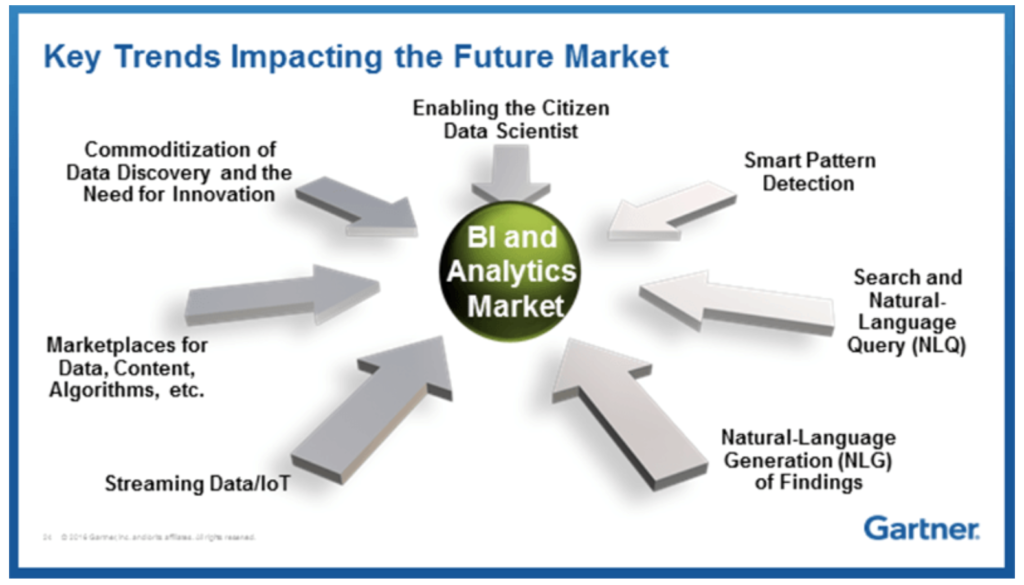We are seeing many predictions lists in articles, newsletters and social media by thought leaders, social media influencers and vendors on predicting the future. Attempting to predict is considered by many to be akin to finding the proverbial ‘unicorn’ or something that is impossible to find or achieve.
What do you think will happen?
No one truly knows what will accurately happen in the future but it is fun to predict. We consolidated input from TekLink and industry experts on their thoughts on what the future holds for business intelligence and analytics.
Here’s what they had to say:

(Gartner/February, 2016 Magic Quadrant for Advanced Analytics Platforms)
Prediction: Gartner predicts these strategic planning assumptions.
Predictive analytics and other categories of advanced analytics represent the fastest-growing segment of the analytics market. Dell joins SAS, IBM, KNIME and RapidMiner as a Leader in this market. By 2018, more than half of large organizations globally will compete using advanced analytics and proprietary algorithms, causing the disruption of entire industries . By 2020, predictive and prescriptive analytics will attract 40% of enterprises’ net new investment in business intelligence and analytics.
(Timo Elliott, VP, Global Innovation Evangelist for SAP)
Prediction: A Cynic’s Guide to BI in 2017
Click here for his guide on LinkedIn. Love your perspective, Tim.
(Doug Heck, Senior Vice President, TekLink)
Prediction: Predicting the effects of external influences on our businesses will become readily possible.
In this past year alone, the need for clients to increase the accuracy of their forecasting has become dire in the face of external influences and factors outside the control of a typical corporation. Look at the ripple effect of oil prices, the California drought or the 30% reduction the US honey-bee population in the last 5 years. Each of these external factors has a profound effect on almost every industry whether directly or indirectly. In 2017, predicting such external influences will become readily possible by the convergence of many technologies from in-memory technologies to big data to cloud computing to open source computational statistics. We are just beginning to see the incredible impact of the convergence of such technologies allowing companies to make incredible leaps and bounds in forecast accuracies via predictive analytics without the old constraints of long lead times and unmanageable volumes of data.
Prediction: Cloud Computing will continue its torrid pace of growth.
Cloud Computing, whether it’s SaaS, PaaS or IaaS, will continue its torrid pace of growth. We see this trend continuing and likely over the next few years. Once companies have gotten over the fear of ‘security’ concerns, the adoption has been tremendous as the costs advantages of Cloud Computing coupled with agility are too compelling to ignore. The indirect and perhaps unforeseen benefit of Cloud Computing for Analytics is the increased better use of IT dollars spent for multiple initiatives across an organization. In layman terms, ‘more bang for your buck’ will allow for more strategic, higher ROI projects to be funded at every customer, and that’s a win-win for everyone. Look for further adoption of Cloud in 2017 with more derivations of Cloud software coming. Also, keep in mind that closing borders and national interest might become an obstacle for cloud if the current political trend continues.
Prediction: Analytic use cases will increase in in-memory databases and applications.
The good news for customers in 2017 is the expected downward pressure of in-memory data base suppliers to lower prices. In fact, we expect price points to continue to drop as the in-memory technologies become ubiquitous over the next 3 years. Multiple and new vendors continue to spring up but I do expect the core market to consolidate, competing for this large and fast growing multi-billion-dollar market . The current large vendors such as SAP, Oracle and Microsoft will continue to expand offerings solely based on their In-memory database platforms. SAP for example with their HANA in-memory database has bet the company on this technology which is be pervasive throughout their offerings and growth strategy. If you are an SAP customer, it’s a matter of when, not if you will be on HANA. Thus, the adoption of analytics running on in-memory databases is close to if not already commonplace in large organizations. The lowering price point will continue to push this trend to the sub billion dollar enterprises, finally making in-memory analytics pervasive regardless of the size of your organization.
Prediction: Agile Methodologies adoption will increase.
Agile methodologies have become the norm in successful analytics projects. Analytics projects have always struggled with a pure waterfall approach. For something like analytics that requires a high degree of user and business interaction, an agile approach is an absolute must. The key is reducing the risk of false requirements and expectations from the business user when it comes to visualization, ease of use and ergonomics. A pure waterfall technique tends to increase risk as well as time to value. By nature of the definition of Analytics, an Agile project methodology lends itself to provide quicker resolutions and a faster delivery where not everything can be defined well enough during Design (what Waterfall based methodologies typically assume). For 2017 onwards, we expect to see more Agile/SCRUM based analytics project management as companies look to not only to reduce costs based on technologies, but also better methodologies and governance.
(Deepa Bhatti, Client Partner Manager, TekLink)
Prediction: Natural Language Processing integration with big data.
With the advancement in technology and success of Natural Language Processing (NLP) in the Amazon Echo and Google Home smart speakers, 2017 will bring the very first NLP for data analysis for structured and unstructured data. The significant demand across industries for improved language capabilities with fast response times to questions or variables in a conversation will help companies better understand and predict human behavior. The benefit of merging NLP with data analysis will for one example help managers understand what words in a sales call help or not help close a sale. In 2017, NLP will allow computers to understand and find meaning with merging data and verbal communication.
(Brian Milone, Director of Business Development, TekLink)
Prediction: “The Trump Effect” will be pro-business in the US.
The ushering in of a new “pro-business” president and a GOP controlled House and Senate could have significant impacts on American companies. New regulations and laws associated with immigration, foreign trade, labor relations, pay equity, employment leave, health insurance, energy, banking, and workplace safety could have a significant impact on both short and long-term financial results. Simply looking at the impact the election has already had on the financial markets makes it easy to project there will also be major financial implications for many US companies. Markets and industries exposed to the high volatility of commodities and other economic factors over the last 15 years will need the ability to factor in these new “Trump Effect” variables into their forecasts or at a minimum, can run multiple “what-if” scenarios to vet out possible outcomes. For example, fossil fuel companies hamstrung by increased government regulation over the last 8 years may feel a lightening of the reigns that open new opportunities whereas renewable energy companies may need to tighten their belts for the next 4-8 years. An inability to quickly and flexibly build in these drivers to your forecasts could be costly both monetarily and from an opportunity lost perspective.
Andreas Wilmsmeier, Vice President / Managing Director, TekLink International AG, Switzerland
Prediction: Service Oriented Architectures (SOA) are coming back.
SOA has been quite a hype a while back, but – as many other technology hypes – did not live up to the expectations at the time. It is now coming back, driven by Cloud Services offered by IBM (Watson), Microsoft (Azure), or SAP (HANA Cloud Platform), by increased network bandwidth and a set of standardized, open communication protocols and interfaces. Service oriented architectures will enable distributed, federated analytic architectures, moving away from monolithic data warehouse and a high degree of (controlled) data redundancy. While this will simplify data logistics and offers a whole new range of options when it comes to advanced analysis of large sets of data, a distributed approach will pose new challenges, such as protecting data and insights from unauthorized access, ensuring a consistent quality of analysis results across multiple platforms to managing the performance of complex analysis distributed across multiple platforms.
Jim Hiepler-Hartwig, Senior Marketing Specialist, TekLink
Prediction: Many companies will continue leverage advanced analytics with no end in mind.
Some of the progressive companies have started building a playground for data scientist, business units and IT that facilitates using advanced analytics in a lab to explore data with no initially intended outcome. They are doing true data exploration and seeing where the data takes them!
Gary Baily, Director, Sales & Business Development EMEA, TekLink
Prediction: Customers will demand analytics on all data.
Platforms that are data and source agnostic will thrive while those that are purpose-built for such as Hadoop and others fail to deploy across use cases will fall by the wayside. The exit of Platfora serves as an early indicator of this trend.
As a result, demand is growing for analytical tools that seamlessly connect to and combine a wide variety of cloud-hosted data sources. Such tools enable businesses to explore and visualize any type of data stored anywhere, helping them discover hidden opportunity in their IoT investment.
Prediction: Big data becomes fast and approachable
You can perform machine learning and conduct sentiment analysis but people often ask: how fast is the interactive SQL? Isn’t SQL the conduit to business users who want to use something like Hadoop data for faster, more repeatable KPI dashboards as well as exploratory analysis?
This need for speed has fueled the adoption of faster databases like Exasol and MemSQL or Hadoop-based stores like Kudu and other technologies that enable faster queries. Using SQL-on-Hadoop engines (Apache Impala, Hive LLAP, Presto, Phoenix, and Drill) and OLAP-on-Hadoop technologies (Jethro Data, Kyvos Insights etc.), these query accelerators are further blurring the lines between traditional warehouses and the world of big data!
Now that you have seen our list of predictions, we would like you to add your comments below.
Looking forward to what the future will bring!










